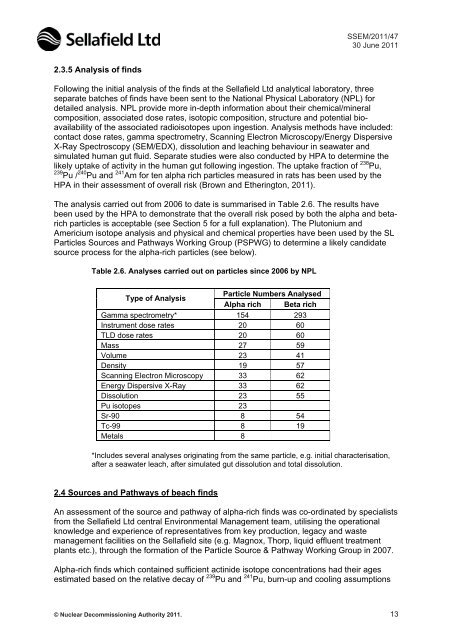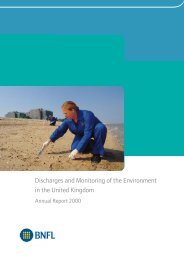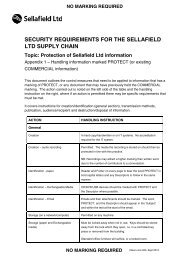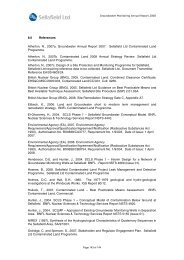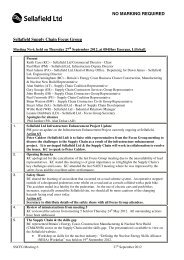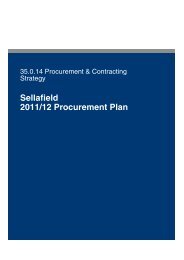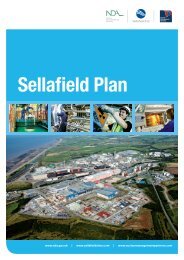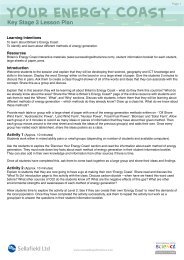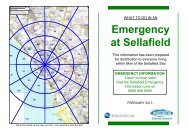Annual Report for 2010/11 and Forward Programme - Sellafield Ltd
Annual Report for 2010/11 and Forward Programme - Sellafield Ltd
Annual Report for 2010/11 and Forward Programme - Sellafield Ltd
Create successful ePaper yourself
Turn your PDF publications into a flip-book with our unique Google optimized e-Paper software.
SSEM/20<strong>11</strong>/4730 June 20<strong>11</strong>2.3.5 Analysis of findsFollowing the initial analysis of the finds at the <strong>Sellafield</strong> <strong>Ltd</strong> analytical laboratory, threeseparate batches of finds have been sent to the National Physical Laboratory (NPL) <strong>for</strong>detailed analysis. NPL provide more in-depth in<strong>for</strong>mation about their chemical/mineralcomposition, associated dose rates, isotopic composition, structure <strong>and</strong> potential bioavailabilityof the associated radioisotopes upon ingestion. Analysis methods have included:contact dose rates, gamma spectrometry, Scanning Electron Microscopy/Energy DispersiveX-Ray Spectroscopy (SEM/EDX), dissolution <strong>and</strong> leaching behaviour in seawater <strong>and</strong>simulated human gut fluid. Separate studies were also conducted by HPA to determine thelikely uptake of activity in the human gut following ingestion. The uptake fraction of 238 Pu,239 Pu / 240 Pu <strong>and</strong> 241 Am <strong>for</strong> ten alpha rich particles measured in rats has been used by theHPA in their assessment of overall risk (Brown <strong>and</strong> Etherington, 20<strong>11</strong>).The analysis carried out from 2006 to date is summarised in Table 2.6. The results havebeen used by the HPA to demonstrate that the overall risk posed by both the alpha <strong>and</strong> betarichparticles is acceptable (see Section 5 <strong>for</strong> a full explanation). The Plutonium <strong>and</strong>Americium isotope analysis <strong>and</strong> physical <strong>and</strong> chemical properties have been used by the SLParticles Sources <strong>and</strong> Pathways Working Group (PSPWG) to determine a likely c<strong>and</strong>idatesource process <strong>for</strong> the alpha-rich particles (see below).Table 2.6. Analyses carried out on particles since 2006 by NPLType of AnalysisParticle Numbers AnalysedAlpha rich Beta richGamma spectrometry* 154 293Instrument dose rates 20 60TLD dose rates 20 60Mass 27 59Volume 23 41Density 19 57Scanning Electron Microscopy 33 62Energy Dispersive X-Ray 33 62Dissolution 23 55Pu isotopes 23Sr-90 8 54Tc-99 8 19Metals 8*Includes several analyses originating from the same particle, e.g. initial characterisation,after a seawater leach, after simulated gut dissolution <strong>and</strong> total dissolution.2.4 Sources <strong>and</strong> Pathways of beach findsAn assessment of the source <strong>and</strong> pathway of alpha-rich finds was co-ordinated by specialistsfrom the <strong>Sellafield</strong> <strong>Ltd</strong> central Environmental Management team, utilising the operationalknowledge <strong>and</strong> experience of representatives from key production, legacy <strong>and</strong> wastemanagement facilities on the <strong>Sellafield</strong> site (e.g. Magnox, Thorp, liquid effluent treatmentplants etc.), through the <strong>for</strong>mation of the Particle Source & Pathway Working Group in 2007.Alpha-rich finds which contained sufficient actinide isotope concentrations had their agesestimated based on the relative decay of 239 Pu <strong>and</strong> 241 Pu, burn-up <strong>and</strong> cooling assumptions© Nuclear Decommissioning Authority 20<strong>11</strong>. 13


